
Anuradhapura is a major city in Sri Lanka. It is the capital city of North Central Province, Sri Lanka and the capital of Anuradhapura District. Anuradhapura is one of the ancient capitals of Sri Lanka, famous for its well-preserved ruins of an ancient Sinhala civilization. It was the third capital of the kingdom of Rajarata, following the kingdoms of Tambapanni and Upatissa Nuwara.

For more than a thousand years, Tibetan artists have played a key role in the cultural life of Tibet. From designs for painted furniture to elaborate murals in religious buildings, their efforts have permeated virtually every facet of life on the Tibetan plateau. The vast majority of surviving artworks created before the mid-20th century are dedicated to the depiction of religious subjects, with the main forms being thangka, distemper paintings on cloth, Tibetan Buddhist wall paintings, and small statues in bronze, or large ones in clay, stucco or wood. They were commissioned by religious establishments or by pious individuals for use within the practice of Tibetan Buddhism and were manufactured in large workshops by monks and lay artists, who are mostly unknown.

Mihintale is a mountain peak near Anuradhapura in Sri Lanka. It is believed by Sri Lankans to be the site of a meeting between the Buddhist monk Mahinda and King Devanampiyatissa which inaugurated the presence of Buddhism in Sri Lanka. It is now a pilgrimage site, and the site of several religious monuments and abandoned structures.
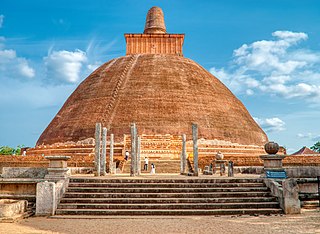
The Jetavanarama stupa or Jetavanaramaya is a stupa, or Buddhist reliquary monument, located in the ruins of Jetavana monastery in the UNESCO world heritage city of Anuradhapura, Sri Lanka. At 122 metres, and was the world's tallest stupa; and the third tallest structure in the world when it was built by King Mahasena of Anuradhapura (273–301). He initiated the construction of the stupa following the destruction of the Mahaviharaya of Anuradhapura. His son Maghavanna I completed the construction of the stupa, and was renovated by Parakramabahu I of Polonnaruwa. A part of a sash or belt tied by the Buddha is believed to be the relic that is enshrined here.

Buddhist art is art influenced by Buddhism. It includes depictions of Buddhas and bodhisattvas, notable Buddhist figures both historical and mythical, narrative scenes from their lives, mandalas, and physical objects associated with Buddhist practice, such as vajras, bells, stupas and Buddhist temple architecture. Buddhist art originated on the Indian subcontinent, following the historical life of Siddhartha Gautama from the 6th to 5th century BCE.

The Ruwanweli Maha Seya, also known as the Mahathupa is a stupa in Anuradhapura, Sri Lanka. Two quarts or one Dona of the Buddha's relics are enshrined in the stupa, making it the largest collection of his relics anywhere. It was built by Sinhalese King Dutugemunu in c. 140 B.C., who became king of Sri Lanka after a war in which the Chola King Elāra (Ellalan) was defeated. It is also known as Swarnamali Seya, Svaṇṇamāli Mahaceti and Rathnamali Seya.

Abhayagiri Vihāra was a major monastery site of Mahayana, Theravada and Vajrayana Buddhism that was situated in Anuradhapura, Sri Lanka. It is one of the most extensive ruins in the world and one of the most sacred Buddhist pilgrimage cities in the nation. Historically it was a great monastic centre as well as a royal capital, with magnificent monasteries rising to many stories, roofed with gilt bronze or tiles of burnt clay glazed in brilliant colors. To the north of the city, encircled by great walls and containing elaborate bathing ponds, carved balustrades and moonstones, stood "Abhayagiri", one of seventeen such religious units in Anuradhapura and the largest of its five major viharas. One of the focal points of the complex is an ancient stupa, the Abhayagiri Dagaba. Surrounding the humped dagaba, Abhayagiri Vihara was a seat of the Northern Monastery, or Uttara Vihara and the original custodian of the Tooth relic in the island.

The Samadhi Buddha is a famous statue situated at Mahamevnāwa Park in Anuradhapura, Sri Lanka. The Buddha is depicted in the position of the Dhyana Mudra, the posture of meditation associated with his first Enlightenment. This statue is 7 feet 3 inches in height and carved from dolomite marble.. It is similar to the Toluvila statue from the same period. It is similar to Gupta period Buddha images, it is believed that originally the image was gilded and had inlaid eyes made of precious gems. It is likely that it was one of the four statues around a sacred Bodhi tree shrine. This is the only one that has survived largely intact.

The Avukana statue is a standing statue of the Buddha near Kekirawa in North Central Sri Lanka. The statue, which has a height of more than 46 feet (14 m), was carved out of a large granite rock face during the 5th century. It depicts a variation of the Abhaya mudra, and the closely worn robe is elaborately carved. Constructed during the reign of Dhatusena, it may have been made as a result of a competition between a master and a pupil. The Avukana statue is one of the best examples of a standing statue built in Sri Lanka. It is now a popular tourist attraction.

The Tissamaharama Raja Maha Vihara is an ancient Buddhist temple in Tissamaharama, Southern Province of Sri Lanka. It was one of the four major Buddhist monasteries established in Sri Lanka, after the arrival of Arhant Mahinda Thera to the country. The site of the Tissamaharama Raja Maha Vihara was consecrated by Buddha himself, who spent some time in meditation there with 500 arhats, during his third visit to the island. Tissamaharama monastery had been recognized as a pre-eminent Buddhist educational center of the southern Sri Lanka from the 3rd century B.C. to the 11th century A.D. The Tissamaharama Dagoba which is situated in the premises of the monastery is one of the largest stupas in Sri Lanka. The present chief incumbent of Tissamaharama Raja Maha Vihara is Ven. Devalegama Dhammasena Nayaka Thera.

Stupas, also called dagebas and cetiyas, are considered an outstanding type of architectural creation of ancient Sri Lanka. Under the influence of Buddhism, there were several changes in the field of architecture in Sri Lanka. The stupa commands a prominent place among these changes. The Stupa is also known by synonymous names such as Chaithya, Dagaba, Thupa, Seya and Vehera. Stupas designed and constructed in Sri Lanka are the largest brick structures known to the pre-modern world.
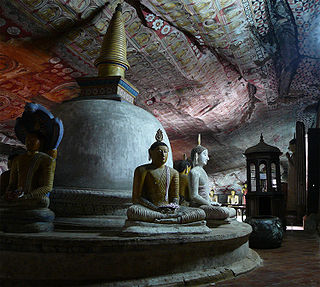
Dambulla cave temple also known as the Golden Temple of Dambulla is a World Heritage Site (1991) in Sri Lanka, situated in the central part of the country. This site is situated 148 kilometres (92 mi) east of Colombo, 72 kilometres (45 mi) north of Kandy and 43 km (27 mi) north of Matale

the Kingdom of Polonnaruwa was the kingdom that ruled the island of Sri Lanka and several overseas territories, from 1070 until 1232. The kingdom started expanding its overseas authority during the reign of Parakramabahu the Great.
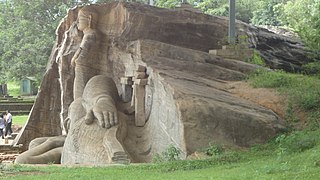
The Gal Vihara, and originally as the Uttararama, is a rock temple of the Buddha situated in the ancient city of Polonnaruwa in North Central Province, Sri Lanka. It was fashioned in the 12th century by Parakramabahu I. The central feature of the temple is four rock relief statues of the Buddha, which have been carved into the face of a large granitic rock. The images consist of a large seated figure, another smaller seated figure inside an artificial cavern, a standing figure and a reclining figure. These are considered to be some of the best examples of ancient Sinhalese sculpting and carving arts, and have made the Gal Vihara the most visited monument at Polonnaruwa.

The Polonnaruwa Vatadage is an ancient structure dating back to the Kingdom of Polonnaruwa of Sri Lanka. It is believed to have been built during the reign of Parakramabahu I to hold the Relic of the tooth of the Buddha or during the reign of Nissanka Malla of Polonnaruwa to hold the alms bowl used by the Buddha. Both these venerated relics would have given the structure a great significance and importance at the time. Located within the ancient city of Polonnaruwa, it is the best preserved example of a vatadage in the country, and has been described as the "ultimate development" of this type of architecture. Abandoned for several centuries, excavation work at the Polonnaruwa Vatadage began in 1903.
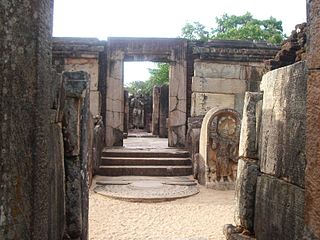
Hatadage is an ancient relic shrine in the city of Polonnaruwa, Sri Lanka. It was built by King Nissanka Malla, and had been used to keep the Relic of the tooth of the Buddha. The Hatadage had been built using stone, brick and wood, although only parts of the brick and stone walls now remain. It appears to have been a two-storey structure, but the upper storey has now been destroyed. Three Buddha statues carved out of granite rock are located within a chamber of the shrine.

The Maligawila Buddha statue is a standing figure of the Buddha in Sri Lanka, which was carved out of a large limestone rock during the 7th century by a prince named Aggabodhi. It is the tallest free-standing ancient statue of the Buddha found in the country. It had been broken into several pieces by the time it was found in 1951. The statue was reconstructed and raised again in 1980 under the direction of the then president Ranasinghe Premadasa.
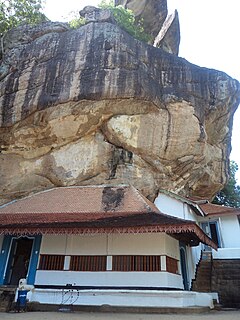
Ridi Viharaya or Silver Temple is a 2nd-century BCE Theravada Buddhist temple in the village of Ridigama, Sri Lanka. Built during the reign of Dutthagamani of Anuradhapura, the temple is considered as the place where the silver ore, which provided silver to complete Ruwanwelisaya; one of the largest stupa in Sri Lanka, was discovered. According to the chronicles Mahavamsa and Thupavamsa, the Ridi Viharaya complex was built in gratitude for helping him cherish his dream of completing Ruwanwelisaya.

Gadaladenyia Vihara is an ancient Buddhist temple situated in Pilimathalawa, Kandy, Sri Lanka. It is located on Gadaladenyia Road (B116), just up from the Gadaladeniya junction of the Colombo - Kandy Road (A1), approximately 12.5 km (7.8 mi) to the west of Kandy and 3 km (1.9 mi) from the ancient buddhist temple, Lankatilaka Vihara. It is considered one of the largest rock temples in Sri Lanka.

Dharmachakra Pravartana Buddha at Sarnath is the famous Gupta period sculpture of the Buddha Shakyamuni in the Dharmachakra Pravartana mudra discovered during the excavations at Sarnath, near Varanasi in Uttar Pradesh, India. It is regarded to be the masterpiece of Gupta art and craftsmanship and has been widely reproduced. After the Lion Capital of Ashoka, which now serves as the symbol of the nation of India, this is the best known sculpture at Sarnath. This 5 feet 3 inch sandstone sculpture is now preserved at the Sarnath Museum, catalogue no. [B(b)181]



















